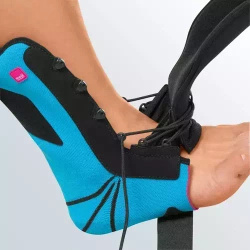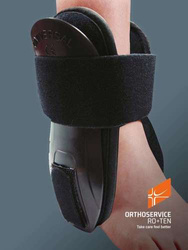Hinged ankle braces
( number of products: 46 )Choosing an ankle-foot orthosis
If you’ve experienced foot and ankle injuries, such as sprains and dislocations, or suffer from foot drop, an ankle foot orthosis afo can help you regain stability and speed up your recovery process. Read on to learn why so many people choose an ankle support brace over traditional plaster casts
The ankle joint is one of the most complex and thus, the most vulnerable elements of the human osteoarticular system. Injuries to this joint are quite common and can be difficult to treat. So how should you protect your foot and ankle from them? An ankle foot orthosis is your best option.
What is an ankle-foot orthosis?
As the name suggests, this is a type of stabilizer designed to support the foot and ankle by partially immobilizing the joint. It works similarly to a plaster cast, but it is much lighter.
Getting around with an ankle support brace is much easier than with a cast, since the stabilizer does not entirely immobilize the limb, allowing for the wearer to undergo rehabilitation without being overburdened. This allows for a faster recovery.
A reliable orthosis (afo) is often made of skin-friendly materials that do not irritate the wearer.
An ankle and foot orthosis afo is categorized based on the material it is made of - these variants include:
- A seamless ankle brace in the form of a band, made of flexible material that has the appropriate degree of medical compression.
- A pneumatic ankle foot orthosis is made of thermoplastic materials that have special air pockets, which adhere to the ankle on both sides.
- A hinged ankle support brace has special locks that control the range of motion of the foot, and encapsulates it with special breathable materials, which provide a fresh air supply to the skin.
Most orthoses available on the market are also made of antibacterial materials.
How does an ankle support brace work?
As mentioned previously, an ankle brace is designed to immobilize the ankle foot joint, and to also strengthen the muscles in the foot. Such braces are often worn prophylactically, and when worn, heat is generated around the joint, which increases blood circulation, thus speeding up the recovery process and helping to relieve pain caused by certain injuries or rheumatic disorders.
What types of injuries can an ankle-foot orthosis help treat?
There are three basic types of ankle injuries:
Dislocations - an injury to the joint capsule and the joint ligaments surrounding it. This occurs when parts of the ankle move unnaturally towards each other. Dislocations are usually caused by incorrect foot positioning, which is common during physical activities. Symptoms include severe pain and swelling of the ankle, which prevents normal walking.
Sprains - this injury involves damage to the ligaments of the ankle and foot and is divided into three stages. The first involves a slight tear in one of the ligaments. During the second stage, there is a partial rupture of the ligament fibers, causing minor instability. In the third stage, the fiber ruptures completely and there is a complete lack of stability. Of course, the higher the stage, the greater the swelling and pain felt in the foot and ankle.
Fractures - this injury involves damage to the shin and sometimes the fibula. This type of injury is so serious that if it occurs, only surgery can help treat affected areas. To avoid this situation from occurring, an orthosis afo is recommended. If you are a physically active individual or have a tendency of sustaining injuries, then you should consider wearing this kind of brace every day.
In the case of more serious injuries however, the ankle-foot orthosis might not be enough to help you recover. In this case, resorting to a plaster cast in order to fully immobilize the foot would be your best bet.
How to choose the right ankle support brace?
It is not recommended for you to choose an ankle support orthosis yourself - speak with a medical specialist and ask which model would be best-suited for your condition. Only someone with experience should be entrusted with doing so. Consult with an orthopedic surgeon, physiotherapist or even a medical store representative who is knowledgeable and has experience. Although the above-mentioned people may recommend an ankle-foot orthosis, only an orthopedic surgeon can decide whether or not you require this form of treatment. An incorrectly chosen brace will make it difficult for the patient to fully recover, and may cause additional pain.
Therefore, it is important that the right model and ankle brace size is selected. If your doctor recommends that you purchase an orthosis, visit a medical store that sells orthopedic products. There, retailers will certainly help find a stabilizer that will provide comfort and allow for a fast recovery.
Patient comfort is extremely important when choosing the right brace, which is why trying on several models is recommended. By doing so, you will be able to see which product reduces discomfort and helps you to regain natural mobility.
Stiff, semi-rigid or soft braces?
A properly-selected orthosis will guarantee you a comfortable road to recovery. Therefore, we do not recommend that you simply take the first braces supports you see off the shelf. When deciding on a brace, an important criteria you need to pay special attention to is the brace’s rigidity. An orthosis afo falls into one of three categories, which are:
1.Rigid - this variant is especially popular with athletes, as it is very effective for treating sprains.
2. Semi-rigid - this variant is intended for people in the final stages of treatment.
3.Soft - this variant is intended mainly for elderly users.
How to choose an ankle sports brace?
If you’re looking to purchase an ankle brace for sports, you need to bear in mind that it must endure weight shifts and needs to be more durable than regular braces, while at the same time providing greater mobility. These are some of the most important aspects you should pay attention to when deciding on an ankle foot brace designed to withstand regular physical activity.
Foot drop braces
Aside from treating sprains and dislocations, an ankle foot orthosis may also be used for treating foot drop. A well-chosen ankle support helps to correct the positioning of the foot, thus allowing the wearer to get around safely. It works by helping to lift the foot while walking and prevents the fingers from being dragged on the ground, which protects against falling.
An ankle foot orthosis afo for treating foot drop is rigid and made of carbon fiber, which supports the entire surface of the foot. In turn, this dynamic orthosis allows the wearer to get around with ease. Additionally, we also have arch-lifting substrings.
Fitting the orthosis
We consider looking for foot braces in order to prevent or recover from injuries, as well as for correcting poorly-healed ones. Once we have a preferred model selected, we need to see if it’ll be able to bear our weight - the heavier the patient, the more durable the brace must be.
An effective method for choosing the right ankle-foot brace is to carry out a so-called "functional test". This involves testing the effectiveness of the orthosis in various situations, such as walking on gravel, a sloped surface or climbing stairs with the brace on.
Which option is better - a brace or plaster cast?
If an injury is not serious enough for your doctor to recommend a plaster cast, it is best that you choose an orthosis. In addition to the above-mentioned advantages, such as being lightweight, the orthosis has several other features that give it an advantage over plaster casts.
A heavy plaster cast does not only cause discomfort, it can create worse side effects. By wearing a plaster cast in the later stages of treatment, applying too much pressure on the bone can make it more difficult to repair. Prolonged wear of a cast may also cause skin maceration (the buildup of moisture and loosening of the skin). Incorrectly placed casts can be very dangerous to your health, as they can compress muscles and nerves, and as a result lead to numbness of the limb and gradual muscle degeneration.
The ankle support brace stabilizes the joint and maintains a constant temperature, which supports blood circulation and prevents necrosis. An important feature of the stabilizer is that it can be easily removed - allowing for the wearer to maintain good personal hygiene of the affected limb.
How much does an ankle-foot brace cost?
As with many other products, prices vary widely, from €25 and upwards. This is influenced by many factors, including the material from which they are made from and the degree of stabilization.

3-fold modular orthosis for functional treatment of ankle joint injuries levamed stabili tri medi

Ankle brace with non-elastic figure of 8 straps, lace fastening and side reinforcements Orthoservice

Ankle support in AirX™ fabric with elasticated figure of 8 straps and spiral stays MalleoFIT 81 Orthoservice

















